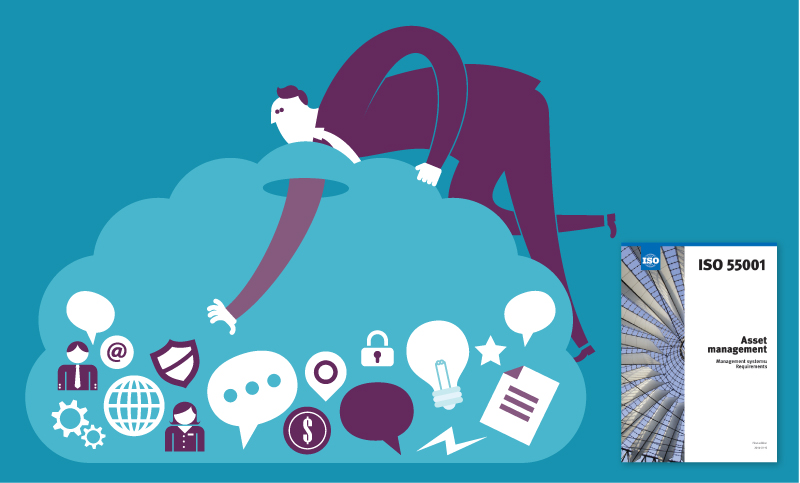The long-awaited ISO 55000 series of standards was officially released in January 2014 and is composed of three separate standards.
The first—ISO 55000, “Overview, Principals and Terminology”—provides a summary of what asset management is, basic business case descriptions, a structure for a good asset management regime, and a glossary of terms used throughout the documents. This first standard lays the foundation and overall framework; it’s generic and can be adapted to specific organization needs. There is a good deal of flexibility to allow use of existing plans and other documents many organizations already have.
Good asset management provides a means to ensure an organization’s physical assets provide good financial performance, output/services delivery, safety of employees and the public, compliance with environmental standards, a way to maintain a good public image, and so on. The organization can demonstrate it’s using good practices by following the requirements of the standards, documenting what it’s doing, the results it’s getting, and what it’s doing to ensure continued alignment of actions and results with objectives. The standards implicitly follow the Deming quality cycle: plan, do, check, and act.
Any organization, such as a municipality, has assets, and it operates with overall objectives as described in its corporate strategy or charter, which defines what it’s there to do. Those assets are intended to deliver on those various stated objectives. The asset management system creates the link from corporate or municipal objectives (such as maintaining public health) to establish policy, asset management objectives (such as providing a reliable source of potable water), and processes through which to achieve them (such as how to operate and maintain a water treatment plant). Asset management itself is the activity of executing on that full set of processes to realize value as the organization defines it from those assets.
Rhys Davies, the chairman of the committee that developed the standard, says the major benefit is being able to realize value from an organization’s assets. “Value doesn’t necessarily mean monetary gain, and defining what the value is for an asset is often a conversation that happens with people outside the company or organization. For example, there has been a lot of interest from cities in this standard. The notion of value from a public park will not be expressed in monetary terms, and defining it will mean getting closer to those using the public park. This is very beneficial for many organizations.”
An asset management system is not an information technology (IT) system. It’s a business management system that may—and likely does—make use of IT in the management of processes and documentation, but the system overall is much more than that.
In the second standard—ISO 55001, “Management Systems – Requirements”—we find the meat of the standards: what is required to be in place to have a complete asset management system. It contains elaboration on what is needed with respect to:
- Organizational context;
- Leadership;
- Planning;
- Support;
- Operation;
- Performance evaluation; and
- Improvement.
Each of these topics is described in some detail, explaining what and why it is required, but it does not prescribe “how.” For instance, under “Leadership,” you’ll find requirements to establish and maintain policy, plans, and objectives, and integrate them with the organization’s overall objectives. It speaks to communications, the importance of personnel, cross-functional collaboration, various roles and responsibilities, continuous improvement, and managing risks. How you do it is up to you—and guided by the content of the third and final standard.
ISO 55002 contains guidelines for applying the seven clusters of requirements. It contains suggestions, tips, and descriptions of various good practices. It is numbered to correspond with ISO 55001, making cross referencing between documents easy. It ties the high level requirements (ISO 55000) along with “why” they are needed with the specific requirements of ISO 55001 while also offering a great deal of “how.” ISO 55002 is an excellent guideline in that a user can dig deeply into asset management issues and create a comprehensive strategic asset management plan for his or her organization. It is not prescriptive, but it does contain sufficient detail to help someone relatively new to the concepts understand the subject quite well.
These ISO standards were based on the United Kingdom’s PAS 55-1 and PAS 55-1 standards, and similarities to those specifications are evident. Nevertheless, they are written in a more generic way for use across a broad spectrum of organizations with physical assets. They can be used by utilities, municipalities, and industry alike. The differences will show up in how the generic requirements are interpreted and implemented. These standards are written in a style that is easy to understand, interpret, and implement.
All in all, the ISO 55000 standards are excellent tools and a great starting point for good asset management in any municipality. “All assets need maintaining, so although the actions we take to maintain them might be different, both will benefit from long-term plans and strategies,” Davies explains. “Asset management is about knowing what we want to achieve with an asset and how to make it happen.”
James Reyes-Picknell is with Conscious Asset Management in Barrie, Ontario and is a certified management consultant.











